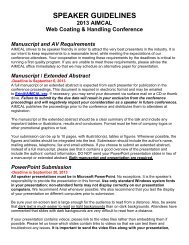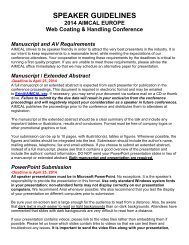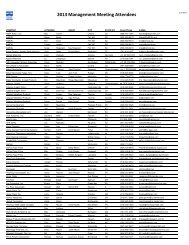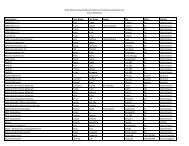Coating - Aimcal
Coating - Aimcal
Coating - Aimcal
Create successful ePaper yourself
Turn your PDF publications into a flip-book with our unique Google optimized e-Paper software.
AiMcAL technical Advisory Panel<br />
The AIMCAL Technical Advisory Panel is a distinguished group of industry consultants selected and approved by the AIMCAL board based<br />
on their years of experience, reputation and contributions to the converting industry. Panel members serve one year terms. They participate<br />
in our Ask AIMCAL service and provide tutorials at AIMCAL technical functions, including the Web <strong>Coating</strong> and Web Handling Conferences<br />
and Converting School. We are proud and honored to have such a distinguished group participating in AIMCAL technical initiatives, and we<br />
are confident that their contributions will continue to strengthen the technical services provided to the AIMCAL membership and the industry.<br />
Prof. steven Abbott<br />
Steven Abbott TCnF<br />
email: steven@stevenabbott.co.uk<br />
Website: www.stevenabbott.co.uk<br />
Professor Steven Abbott<br />
studied chemistry at U.<br />
Oxford, then completed his<br />
Oxford Ph.D. at Harvard.<br />
His post-doc research<br />
occurred in the lab of nobel<br />
Prize winner, Prof. J-M Lehn<br />
in Strasbourg. He worked for 15 years at<br />
ICI on polymer and coating science, then<br />
became research director at Autotype, near<br />
Oxford, who specializes in coatings onto<br />
polyester and polycarbonate films. As a way<br />
of bringing coating science into development<br />
and production, Abbott partnered with the<br />
coatings research group at U. Leeds and<br />
subsequently became a visiting professor<br />
in the School of Mechanical Engineering.<br />
Together with colleagues from the U. Leeds,<br />
he developed TopCoat and TopWeb, which<br />
are used throughout the converting industry<br />
to help optimize coating and converting<br />
conditions and solve real-world production<br />
problems.<br />
When he retired from Autotype he<br />
established Steven Abbott TCnF, where<br />
T=Technical Software, C=<strong>Coating</strong>/Printing,<br />
n=nanocoatings and F=Formulation. His<br />
software solutions include Hansen Solubility<br />
Parameters in Practice, which aids the<br />
understanding of solubility issues; Optimal<br />
Surfactant, which elaborates on surfactant<br />
formulations; Formulating For Efficacy,<br />
which provides solutions to optimize delivery<br />
of active molecules to the skin; and Surface<br />
Profiler, which aids in the understanding<br />
of surface roughness phenomena. He is<br />
currently working on an adhesion modeler to<br />
provide insights into the various mechanisms<br />
of adhesion, which will be covered in his<br />
AIMCAL Adhesion & Adhesives two-day<br />
training course.<br />
With his broad interests, Abbott has published<br />
papers, gained patents and spoken at<br />
conferences on a wide range of subjects<br />
including data storage, organic photovoltaics,<br />
oil-field corrosion, geomembranes, coating<br />
science and surfactant optimization for<br />
cosmetics manufacture.<br />
Although he loves pure science, his passion<br />
is applying science to real-world production.<br />
Because he finds that he often doesn’t<br />
understand a subject just by reading papers<br />
and equations, he writes programs that bring<br />
the academic sciences to life. His hope is<br />
that these models and the science behind<br />
them can help others to troubleshoot their<br />
own development and production issues.<br />
Dr. charles A. Bishop<br />
C.A.Bishop Consulting Ltd<br />
email: cabuk8@btinternet.com<br />
Website: www.cabuk1.co.uk<br />
Blog: www.convertingquarterly.com/blogs/<br />
vacuum-web-coating.aspx<br />
On leaving school at 16,<br />
Charles Bishop served a fouryear<br />
craft apprenticeship in<br />
Mechanical Engineering.<br />
During this time, he also<br />
studied to gain O.n.C.<br />
and H.n.C in mechanical<br />
engineering at the local technical college.<br />
On completing his apprenticeship as a<br />
toolmaker, winning a ‘Best Student’ award<br />
along the way, Bishop entered Loughborough<br />
University and studied for a B.Sc. in Materials<br />
Engineering. On gaining an Honours<br />
degree and a diploma in Industrial Studies,<br />
he moved to the Physics Department to<br />
research vacuum deposition processes and<br />
he went on to gain both an M.Phil. and Ph.D.<br />
by research and thesis.<br />
After a period of time as a post-doctoral<br />
research scientist at the University where<br />
Bishop also took on consultancy work, he<br />
was headhunted into Imperial Chemical<br />
Industries (ICI plc). His first position in ICI<br />
was as a senior research scientist in Surface<br />
Engineering within the new Science Group.<br />
During his time, he worked for businesses as<br />
diverse as nylons, Polyesters, Explosives,<br />
Imagedata and Flex Products Inc. Projects<br />
included taking laboratory processes<br />
through to production, the technical input<br />
during the company selection process for the<br />
acquisition of a vacuum deposition company,<br />
troubleshooting a new $45M explosives<br />
production line, technology scanning to<br />
provide new technologies as part of a route<br />
to new markets, as well as numerous smaller<br />
product development tasks. During this time,<br />
work was carried out in the USA, Europe and<br />
the UK.<br />
In December 1998, Bishop elected to return<br />
to consultancy work and established his<br />
own business, C.A. Bishop Consulting,<br />
Ltd., offering help on all aspects of vacuum<br />
deposition including system design, process<br />
development and scale-up, process control,<br />
plasma surface treatments and coatings, as<br />
well as troubleshooting existing processes<br />
and running training courses.<br />
Bishop has published over 60 technical<br />
papers, has five patents and has managed<br />
training courses in the UK, USA, India<br />
and Europe. In 2007, his book Vacuum<br />
Deposition onto Webs, Films & Foils was<br />
published, which was followed by a second<br />
book Roll-to-Roll Vacuum Deposition of<br />
Barrier <strong>Coating</strong>s in 2010.<br />
Jerry Brown<br />
Essex Systems<br />
email: jlbrown1@optonline.net<br />
Website: www.essexsys.com<br />
Jerry Brown began his career<br />
in web handling in 1960<br />
at Fife Corporation, one of<br />
the leading manufacturers<br />
of web guiding systems.<br />
He was involved in a wide<br />
variety of web-fed processes<br />
and made many important contributions to<br />
the early development and application of web<br />
handling equipment, including the following:<br />
• Independently discovered the normal entry<br />
rule in 1960, which allowed Fife to become<br />
the first company in the US to design<br />
web guide applications with predictable<br />
dynamic performance.<br />
• Conceptualized, in collaboration with an<br />
associate, the first bearing system that<br />
used more than two linear bearings to<br />
support steering rollers.<br />
• Developed numerous optical sensors and<br />
electronic control systems for applications<br />
in converting, textiles and metals.<br />
• Led the development of the world’s first<br />
microprocessor-based online nuclear<br />
thickness gauge.<br />
In 1997, Brown became an independent<br />
web handling consultant. He is a regular<br />
participant in web handling conferences<br />
sponsored by the Web Handling Research<br />
Center at Oklahoma State University and<br />
by AIMCAL. He has developed a modeling<br />
method based on elasticity theory and<br />
commercially available FEA software that<br />
precisely predicts the lateral behavior of<br />
www.aimcal.org | 89











